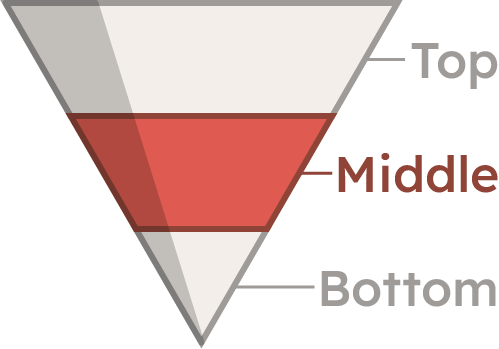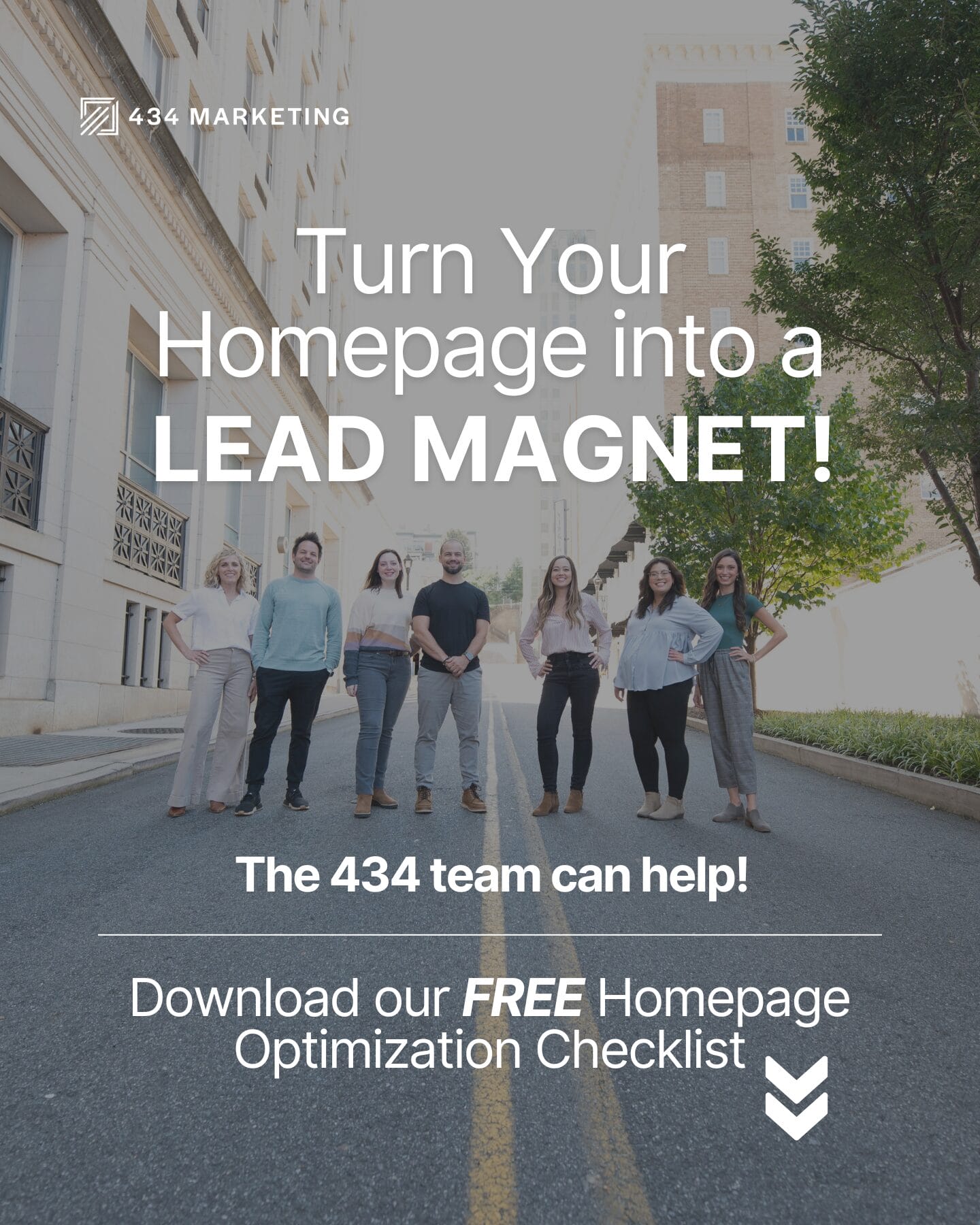Why Your Content Funnel Matters
Content funnels not only draw users to your site, they help improve the quality of leads you receive. If your content clearly guides users from piece to piece, you’ll naturally edit your customer base as they explore your site. As users consume more and more content, they should better understand if there’s alignment between your offering and their needs.
Customers that already understand your offering and have expressed interest in partnering with or patronizing your business are the ones that should get the attention of sales teams. At its most effective, content marketing drives traffic to your site and generates high-quality leads by redirecting the visitors whose needs don’t match your offering.
The content funnel is divided into 3 sections: the top, middle, and bottom of the funnel:
Why Your Content Funnel Matters
Content funnels not only draw users to your site, they help improve the quality of leads you receive. If your content clearly guides users from piece to piece, you’ll naturally edit your customer base as they explore your site. As users consume more and more content, they should better understand if there’s alignment between your offering and their needs.
Customers that already understand your offering and have expressed interest in partnering with or patronizing your business are the ones that should get the attention of sales teams. At its most effective, content marketing drives traffic to your site and generates high-quality leads by redirecting the visitors whose needs don’t match your offering.
The content funnel is divided into 3 sections: the top, middle, and bottom of the funnel:
Why Your Content Funnel Matters
Content funnels not only draw users to your site, they help improve the quality of leads you receive. If your content clearly guides users from piece to piece, you’ll naturally edit your customer base as they explore your site. As users consume more and more content, they should better understand if there’s alignment between your offering and their needs.
Customers that already understand your offering and have expressed interest in partnering with or patronizing your business are the ones that should get the attention of sales teams. At its most effective, content marketing drives traffic to your site and generates high-quality leads by redirecting the visitors whose needs don’t match your offering.
The content funnel is divided into 3 sections: the top, middle, and bottom of the funnel:
Top of Funnel (ToFu)
High traffic volume,
low intent to convert

Top-of-the-funnel (ToFu) content is designed to attract a wide audience and generate awareness for your brand, products, or services. This content aims to educate, entertain, and inspire prospects by providing valuable information and addressing the pain points or challenges your audience may be experiencing.
Content at the top of the funnel generally doesn’t heavily promote your business. Instead, this content is intended to demonstrate your brand’s authority and expertise in the field so visitors will associate your brand with solutions they’ve been seeking for their problems.
Examples of ToFu content:
- Articles: Explain the solutions you offer to your audience’s various pain points.
- Infographics: Distill research on your audience’s pain points and your solution into easy-to-understand, shareable bullet points, charts, and graphs.
- Social media posts: Produce short, shareable posts to grab users’ attention while they scroll social media.
- Podcasts: Demonstrate thought leadership by recording in-depth interviews and conversations surrounding your offering.
- Webinars: Host live webinars or record on-demand webinars, which are similar to podcasts, but generally more educational than entertaining.
Middle of Funnel (MoFu)
Medium traffic volume,
moderate interest in solution

Middle-of-Funnel (MoFu) content comes into play when a prospective buyer is already considering making a change or a purchase. They are aware of your offering and brand, but they are likely also aware of your competitors. At this stage of the funnel, we try to make ourselves stand out against the competition.
It’s time to build a relationship with your audience. Conduct research to understand who they are, what they need, and what they respond to. Provide more specific information about how your offering works and what problems it solves. This is a great time to identify buyers’ pain points and explain how your product or service can eliminate or overcome those barriers.
Examples of MoFu content:
- Tutorials: Create how-to guides for processes relating to your product or service so potential customers can see how much easier your offering can make it.
- Case studies: Record success stories of your clients to demonstrate the real-life benefits of partnering with your business.
- White papers: Create white papers, which are generally longer-form, more in-depth, and downloadable explorations of the same kinds of topics featured in your articles and blog posts to further position yourself as an expert in your field.
- Portfolios: Some products or services might call for a portfolio. Like case studies, portfolios offer potential customers a glimpse of real examples of your work.
Bottom of Funnel (BoFu)
Low traffic volume,
high intent to convert

The bottom of the funnel is the home stretch! Your customer is already committed to making a purchase, and is likely comparing your solution to their current system, as well as one or two competitors offering solutions to the same problems. Bottom-of-funnel content is very product-focused: this is the time to focus on all the bells and whistles of your offering that make it the best option for your customer.
At this point, you’ve built a relationship with your audience and gradually demonstrated your business’ value. Now you get to explain the details of how a partnership or purchase will work. This is a time to provide clarity on things like features, terms, pricing, or any questions the customer may have before they can commit.
Examples of BoFu content:
- Demos: Schedule a demo to show the customer how your product works and answer their questions as they arise.
- Free trials: If possible, offer a free trial to give your customer a chance to interact with your product or service directly and find the answers to their own questions.
- Consultations: Schedule a consultation with the customer to have a one-on-one discussion about their problems and your offering. Consultations can be informative and beneficial for both the customer and your sales team.
- Email campaigns: Email campaigns are a great way to segment your audience and target those furthest along in the buying process with the information only they need.
All of these types of content are important pieces of the overall marketing strategy, working together to usher the right customers into the buying process. Like the parts of a machine, they all need to be the right size and in the right places to work effectively. To improve any system, you need to take inventory first so you know what you’re working with.
Conducting a funnel audit is one way to evaluate whether or not your content aligns with your overall content marketing strategy. By familiarizing yourself with your business’ content, you can use this knowledge to produce more effective marketing content in the future.
How to Conduct a Funnel Audit
Content funnel audits help us take stock of what content we’ve created, and how well it aligns with our overall goals and strategy. After researching what our customers need, and how they are looking for answers, we can develop a plan for reaching the right audience for our business. A content funnel audit helps us visualize and mitigate any gaps in our strategy.
The process is simple:
- Create a spreadsheet: First thing’s first: gather your content. You don’t need to copy all of the content into a document, but you need to identify and organize the content you have produced. If your business publishes a blog (which we recommend!), copy the titles of all the blog posts into a spreadsheet. Some platforms, like WordPress, allow you to export your content’s metadata directly into a spreadsheet. Other tools, like Screaming Frog, will crawl your site for you and pull out all the information you need. Organize your content in a way that allows you to understand which pieces are which, either by title, URL, or some other unique identifier so you can start your deep dive.
-
Analyze your content: Once you have a list of content pieces on your site, start digging! Navigate through your site and re-familiarize yourself with what you’ve published. Make sure you cross-reference your spreadsheet as you go so you don’t miss any pages. As you read your content, take note of who each content piece is targeting and what it’s communicating. Ask the following questions:
-
Is the piece speaking to broad audiences, or individuals with a specific problem?
-
Does the content demonstrate thought leadership by exploring trends, or does it focus on features unique to your offering?
-
What type of content is it?
-
See an Imbalance? Create a Project Plan To Fill Gaps in Your Funnel
Every business’ challenges and goals are unique, but conducting a content funnel audit can help you at least understand where you are in the present. Once you have a solid grasp of where your content falls within the funnel, you can create a plan to bolster the areas that are lacking, or cull content that seems superfluous or redundant in another.
- If your funnel is bottom-heavy, conduct keyword research to see what phrases surrounding your offering are most widely searched or trending. Incorporating these keywords into your content strategy will help you usher more visitors toward your already robust middle- and bottom-of-funnel materials.
- If your funnel is strong at the top and bottom, close the gap by building out your middle-of-funnel content. Focus on the specific problems your business solves. Communicate to visitors that you really, deeply understand what they are going through and what they need. Provide a high-level overview of your product or service without getting too specific so visitors to your site understand that you have solutions, but don’t become overwhelmed.
- If you’re attracting high-volume traffic to your site with effective top-of-funnel content, but the bottom of your funnel is weak, visitors are more likely to bounce, or leave without exploring or interacting with your site. Develop your proof points and content focusing on your offering’s specific features. Include links in your higher-traffic top- and middle-of-funnel pieces to point audiences to your new bottom-of-funnel content so they can dig into the details if they want to.
Balancing a Content Funnel Is No Easy Feat — But We’re Here To Help.
Understanding where you are is the first step toward where you want to be. Content funnel audits are a great way to assess and analyze your content strategy and identify opportunities for improvement.
Here at 434 Marketing, we always start by gleaning an understanding of our clients’ current strengths, weaknesses, and goals before we start developing our strategies that deliver results. We conduct research and in-depth data analysis on your current website before we even start planning for your project, and we bring you along every step of the way.
If you want to tap into the power of data analysis to bolster your marketing strategy, but lack the time and resources, we’re here to help. Schedule a listening meeting with us today so we can learn more about your business, where you are, and where you want to be.




